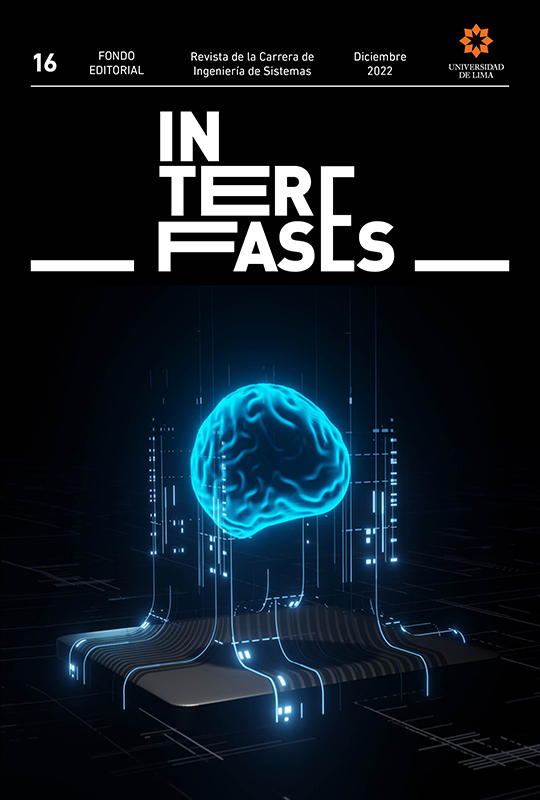Dispositivos wearables y los riesgos a la privacidad: una revisión de la literatura
DOI:
https://doi.org/10.26439/interfases2022.n016.6119Palabras clave:
wearables, riesgos, privacidad, seguridad, controlesResumen
En la actualidad, está en auge del uso de dispositivos que se pueden llevar puestos (wearable devices, en inglés): tanto niños como adultos han incorporado en su día a día este tipo de dispositivos adicionales al celular, que hoy son una extensión más del ser humano. Esta investigación hace una revisión de qué son los wearables, su uso y los riesgos que implican para el usuario en cuanto a su privacidad y su seguridad. Se eligió la metodología de identificación y control de riesgos entre los resultados de una revisión de alcance en la literatura pertinente.
Descargas
Referencias
Almusaylim, Z. A., & Zaman, N. (2018). A review on smart home present state and challenges: Linked to context-awareness Internet of Things (IoT). Wireless Network, 25, 3193-3204. https://doi.org/10.1007/s11276-018-1712-5
Altawy, R., & Youssef, A. M. (2016). Security tradeoffs in cyber physical systems: A case study survey on implantable medical devices. IEEE Access, 4, 959-979. https://doi.org/10.1109/access.2016.2521727
Argentina Cibersegura. (2020). ¿Qué es la privacidad en internet? https://www.argentinacibersegura.org/admin/resources/files/consejos/33/Gu%C3%ADa_sobre_Privacidad.pdf
Arksey, H., & O’Malley, L. (2005). Scoping studies: Towards a methodological framework. International Journal of Social Research Methodology, 8(1), 19-32. https://doi.org/10.1080/1364557032000119616
Cyr, B., Horn, W., Miao, D., & Specter, M. A. (2014). Security analysis of wearable fitness devices (Fitbit). Massachusetts Institute of Technology, 1. https://media.kasperskycontenthub.com/wp-content/uploads/sites/43/2015/03/20082016/17-cyrbritt-webbhorn-specter-dmiao-hacking-fitbit.pdf
Dziubinski, K., & Bandai, M. (2020). Your neighbor knows what you’re doing: Defending smart home IoT device traffic from privacy LAN attacks. En L. Barolli, F. Amato, F. Moscato, T. Enokido & M. Takizawa (Eds.), Web, Artificial Intelligence and Network Applications. WAINA 2020 (pp. 526-534). Springer. https://doi.org/10.1007/978-3-030-44038-1_48
Feal, Á., Calciati, P., Vallina-Rodriguez, N., Troncoso, C., & Gorla, A. (2020). Angel or devil? A privacy study of mobile parental control apps. Proceedings on Privacy Enhancing Technologies, 2, 314-335. https://doi.org/10.2478/popets-2020-0029
Fernández-Caramés, T., & Fraga-Lamas, P. (2018). Towards the internet of smart clothing: A review on IoT wearables and garments for creating intelligent connected e-textiles. Electronics, 7(12), 405. https://doi.org/10.3390/electronics7120405
Girma, A. (2018). Analysis of security vulnerability and analytics of Internet of Things (IOT) platform. En S. Latifi (Ed.), Information Technology - New Generations. 15th International Conference on Information Technology (pp. 101-104). Springer. https://doi.org/10.1007/978-3-319-77028-4_16
González, C. A. (2020). Introducción a la minería de datos. Universidad de Valladolid.
Grant, M. J., & Booth, A. (2009). A typology of reviews: An analysis of 14 review types and associated methodologies. Health Information & Libraries Journal, 26(2), 91-108. https://doi.org/10.1111/j.1471-1842.2009.00848.x
Gubbi, J., Buyya, R., Marusic, S., & Palaniswami, M. (2013). Internet of Things (IoT): A vision, architectural elements, and future directions. Future Generation Computer Systems, 29(7), 1645-1660. https://doi. org/10.1016/j.future.2013.01.010
Hale, M. L., Lotfy, K., Gamble, R. F., Walter, C., & Lin, J. (2019). Developing a platform to evaluate and assess the security of wearable devices. Digital Communications and Networks, 5(3), 147-159. https://doi.org/10.1016/j.dcan.2018.10.009
Hui, S., Wang, Z., Hou, X., Wang, X., Wang, H., Li, Y., & Jin, D. (2021). Systematically quantifying IoT privacy leakage in mobile networks. IEEE Internet of Things Journal, 8(9), 7115-7125. DOI: 10.1109/JIOT.2020.3038639
ISACA Madrid Chapter. (2010). Certified in Risk and Information Systems Control (CRISC).
Klopfenstein, L. C., Delpriori, S., Aldini, A., & Bogliolo, A. (2019). “Worth one minute”: An anonymous rewarding platform for crowd-sensing systems. Journal of Communications and Networks, 21(5), 509-520. https://doi.org/10.1109/jcn.2019.000051
Laricchia, F. (2022). Wearables unit shipments worldwide by vendor from 1st quarter 2014 to 4th quarter 2021. Statista.
Lee, Y., Yang, W., & Kwon, T. (2018). Data transfusion: Pairing wearable devices and its implication on security for Internet of Things. IEEE Access, 6, 48994-49006. https://doi.org/10.1109/access.2018.2859046
Liao, B., Ali, Y., Nazir, S., He, L., & Khan, H. U. (2020). Security analysis of IoT devices by using mobile computing: A systematic literature review. IEEE Access, 8, 120331-120350. https://doi.org/10.1109/access.2020.3006358
Nmap. (2022). Free security scanner for network exploration and security audits. https://nmap.org/
OpenVAS. (2022). A framework for vulnerability scanning and vulnerability management. http://openvas.org/
Organización Internacional de Normalización. (2015). Sistemas de gestión de calidad (ISO 9000:2015). https://www.iso.org/obp/ui/es/#iso:std:iso:9000:ed-4:v1:es
Organización Internacional de Normalización. (2018). Gestión del riesgo (ISO 31000:2018). https://www.iso.org/obp/ui#iso:std:iso:31000:ed-2:v1:es
Peters, M. D., Godfrey, C. M., Khalil, H., McInerney, P., Parker, D., & Soares, C. B. (2015). Guidance for conducting systematic scoping reviews. International Journal of Evidence-Based Healthcare, 13(3), 141-146. https://doi.org/10.1097/XEB.0000000000000050
Reardon, J., Feal, Á., Wijesekera, P., Elazari, A., Vallina-Rodriguez, N., & Egelman, S. (2019). 50 ways to leak your data: An exploration of apps’ circumvention of the android permissions system. USENIX. https://www.usenix.org/conference/usenixsecurity19/presentation/reardon
Seneviratne, S., Hu, Y., Nguyen, T., Lan, G., Khalifa, S., Thilakarathna, K., … Seneviratne, A. (2017). A survey of wearable devices and challenges. IEEE Communications Surveys & Tutorials, 19(4), 2573-2620. https://doi.org/10.1109/comst.2017.2731979
Solera-Cotanilla, S., Fúster, J., Pérez, J., Palacios, R., Vega-Barbas, M., Álvarez-Campana, M., & López, G. (2022). Análisis de problemas de seguridad y privacidad en wearables usados por menores. En Actas de las VII Jornadas Nacionales de Investigación en Ciberseguridad (JNIC 2022) (pp. 209-215). https://www.researchgate.net/publication/361972187_Analisis_de_Problemas_de_Seguridad_y_Privacidad_en_Wearables_Usados_por_Menores
Spil, T. A. M., Romijnders, V., Sundaram, D., Wickramasinghe, N., & Kijl, B. (2021). Are serious games too serious? Diffusion of wearable technologies and the creation of a diffusion of serious games model. International Journal of Information Management, 58. https://doi.org/10.1016/j.ijinfomgt.2020.102202
Tomaz, A. E. B., Nascimento, J. C. D., Hafid, A. S., & De Souza, J. N. (2020). Preserving privacy in mobile health systems using non-interactive zero-knowledge proof and blockchain. IEEE Access, 8, 204441-204458. https://doi.org/10.1109/access.2020.3036811
Torre, I., Sanchez, O. R., Koceva, F., & Adorni, G. (2018). Supporting users to take informed decisions on privacy settings of personal devices. Personal and Ubiquitous Computing, 22, 345-364. https://doi.org/10.1007/s00779-017-1068-3
Tseng, T. W., Wu, C. T., & Lai, F. (2019). Threat analysis for wearable health devices and environment monitoring Internet of Things integration system. IEEE Access, 7, 144983-144994. https://doi.org/10.1109/access.2019.2946081
Udoh, E. S., & Alkharashi, A. (2016). Privacy risk awareness and the behavior of smartwatch users: A case study of Indiana University students. En 2016 Future Technologies Conference (FTC) (pp. 926-931). https://doi.org/10.1109/ftc.2016.7821714
Wireshark. (2022). A network protocol analyzer. https://www.wireshark.org/
Wells, S. (2019, 17 de julio). How Fitbits, other bluetooth devices make us vulnerable to tracking. The Brink. https://www.bu.edu/articles/2019/fitbit-bluetooth-vulnerability/
Wu, M., & Luo, J. (2019). Wearable technology applications in healthcare: A literature review. HIMSS. https://www.himss.org/resources/wearable-technology-applications-healthcare-literature-review
Xue, Y. (2019). A review on intelligent wearables: Uses and risks. Human Behavior and Emerging Technologies, 1(4), 287-294. https://doi.org/10.1002/hbe2.173
Publicado
Número
Sección
Licencia
Los autores/as que publiquen en esta revista aceptan las siguientes condiciones:
Los autores/as conservan los derechos de autor y ceden a la revista el derecho de la primera publicación, con el trabajo registrado con la licencia de atribución de Creative Commons, que permite a terceros utilizar lo publicado siempre que mencionen la autoría del trabajo y a la primera publicación en esta revista.
Los autores/as pueden realizar otros acuerdos contractuales independientes y adicionales para la distribución no exclusiva de la versión del artículo publicado en esta revista (p. ej., incluirlo en un repositorio institucional o publicarlo en un libro) siempre que indiquen claramente que el trabajo se publicó por primera vez en esta revista.
Se permite y recomienda a los autores/as a publicar su trabajo en Internet (por ejemplo en páginas institucionales o personales) antes y durante el proceso de revisión y publicación, ya que puede conducir a intercambios productivos y a una mayor y más rápida difusión del trabajo publicado (vea The Effect of Open Access).
Última actualización: 03/05/21






